#northern zhou dynasty
Explore tagged Tumblr posts
Text
April 13, Xi'an, China, Shaanxi Archaeology Museum/陕西考古博物馆 (Part 3 - Qin dynasty to Sui dynasty):
First up is one of many bronze edict tablets of the 2nd emperor of Qin dynasty, made in 209 BC. Inscribed upon it in Seal script is one of two edicts, specifically the one from the 2nd emperor of Qin dynasty (秦二世), which basically is a continuation of Qin Shi Huang's edict on standardizing all weights and measurements. Here Qin Shi Huang/秦始皇 is referred to as Shi Huangdi/始皇帝, where shi/始 means "origin", and huangdi/皇帝 means "emperor".

^The edict inscribed is as follows (this is my VERY rough translation, please take this with a grain of salt, I'm not great at reading Old Chinese; original text is on bottom right of picture):
“First year (209 BC; first year of 2nd Emperor of Qin's reign), [We] issued an edict to chancellors Li Si and Feng Quji: Shi Huangdi pioneered this effort to standardize all weights and measurements, since then all such edicts have been inscribed on bronze. Now that [We have] inherited this Huangdi title, [We] shall not refer to Ourselves as Shi Huangdi here. Likewise, should Our descendants continue to produce tablets of Shi Huangdi's edict, they shall not take credit for Shi Huangdi's achievements. [We] hereby inscribe this edict on the left, so that all may be clear."
Ever since Qin Shi Huang tried to standardize systems of measurements for the entire country, every dynasty since Qin dynasty has also done the same. These are the standardized weights and volume measurements (all made with bronze) from Western Han dynasty (202 - 8 BC). Those volume measurement tools are very much like oversized measurement spoons, since they are mostly used to measure liquids and grains (in ancient China grains can be measured by volume).

Looks like I forgot about this one in part 2, this is a bronze sword from Warring States period (475 - 221 BC), I believe. It's decorated with carved pieces of jade (some are on the scabbard, but the scabbard has presumably decomposed over time):

The painted and carved stone doorway to a Eastern Han dynasty (25 - 220 AD) tomb. The actual (double) doors are in the middle, and the pieces around them are the side jambs and the lintel. Note the animals, mythical creatures, and humans depicted. On the double doors, in order from top to bottom, there's a pair of Zhuque/朱雀/Vermilion Bird, a pair of symbolic door knockers shaped like a beast carrying a ring in its mouth, and a pair of oxen. On the top right and top left of the lintel piece, you can also clearly see the sun crow and the moon toad, respectively.

The layout of some Western Han dynasty (202 - 8 BC) mausoleums. Note that the "pyramids" on the model aren't stone pyramids like the Great Pyramid of Giza, they are actually fengtu/���土, or artificial mounds of earth on top of the actual tomb to symbolically seal the tomb (feng/封 means "seal" or "to seal"), and can serve as tomb markers. Fengtu can differ vastly in size according to the social status of the deceased, so the fengtu of imperial tombs are usually huge, some so big that they are like small hills. However, while Western Han dynasty imperial tombs have these square-ish fengtu mounds, in Eastern Han dynasty (25 - 220 AD) the fengtu mounds became circular, and imperial tomb fengtu have been circular pretty much ever since. But fengtu wasn't just reserved for the elites, common folk also built small circular fengtu mounds on top of graves (these graves are called fen/坟; graves without fengtu are called mu/墓), and this is still practiced today, albeit much more common in rural areas since there are less people and more land. When people tend to the graves of their family members and ancestors on Qingming Festival, if the grave is a fen grave, people would pile more earth on the fengtu to make it rounder as part of the upkeep process.

A set of pottery figurines of entertainers from a Western Han era tomb. I love how they set the display up here, you can practically imagine the music and the dancing

More pottery figurines from Western Han era tombs

Western Han era hollow clay bricks depicting the Four Symbols/四象 of the cardinal directions: Qinglong/青龙/Azure Dragon of the East, Zhuque/朱雀/Vermilion Bird of the South, Xuanwu/玄武/Black Tortoise of the North, and Baihu/白虎/White Tiger of the West.

Left: a piece of intricately painted lacquered wood, I forgot where it's from but it was probably a piece of decoration on a larger artifact. Right: a piece of gold decoration inlaid with turquoise from Western Han era


The biggest decorated yubi/玉璧 (jade disc with hole in the middle) found so far, from an early Western Han dynasty tomb. Its diameter is 43.2 cm (~17 inches). If you zoom in, the inner band is decorated with these almost tadpole-like little swirls, and these are called gu pattern/谷纹, since they might represent sprouting rice kernels. The outer band is decorated with 4 sets of kuilong patterns/夔龙纹 and 4 sets of dragon-phoenix patterns/龙凤纹. It's speculated that the patterns here together depict the universe, and the hole in the middle is where the spirit of the deceased will travel through. This particular yubi also has 六百六十一 ("six hundred and sixty-one") carved discreetly on the side, presumably a "serial number" left by the artisan who crafted this piece.

Decorated backs of bronze mirrors. I didn't take a picture of the plaque so I'm unclear on what time period these are from (may or may not be from the time period indicated at the beginning of the post):

Left: a hand-held incense burner. Right: a particular type of incense burner called a boshanlu/博山炉, so named because the lid was made to look like a mini mountain


Various Northern Zhou dynasty (557 - 581 AD) painted pottery figurines. Below middle arranged in a circle is the metal pieces on a belt.

Sixteen Kingoms era pottery entertainer figurines:

#2024 china#xi'an#china#shaanxi archaeology museum#chinese history#chinese culture#qin dynasty#han dynasty#northern zhou dynasty#sixteen kingdoms period#archaeology#history#culture
228 notes
·
View notes
Text

Archaeologists Discover 1,500-Year-Old Tomb of Ancient Emperor in China
An inscription on the 1,400-year-old tomb shows the dead man, who was posthumously declared emperor, was buried as a duke.
The 1,400-year-old tomb of a Chinese emperor confirms a political power struggle between royal brothers and a warlord that, until now, was known only from historical records.
The official Chinese news agency Xinhua reported last week that archaeologists had unearthed the tomb near the city of Xianyang in Shaanxi province, about 560 miles (900 kilometers) southwest of Beijing.
The report said the tomb holds the remains of Emperor Xiaomin — also known by his personal name, Yuwen Jue — who is regarded as the founder of the Northern Zhou dynasty in 557. But historians say Jue was deposed and executed after ruling for only a few months and that he wasn't proclaimed emperor until decades later.
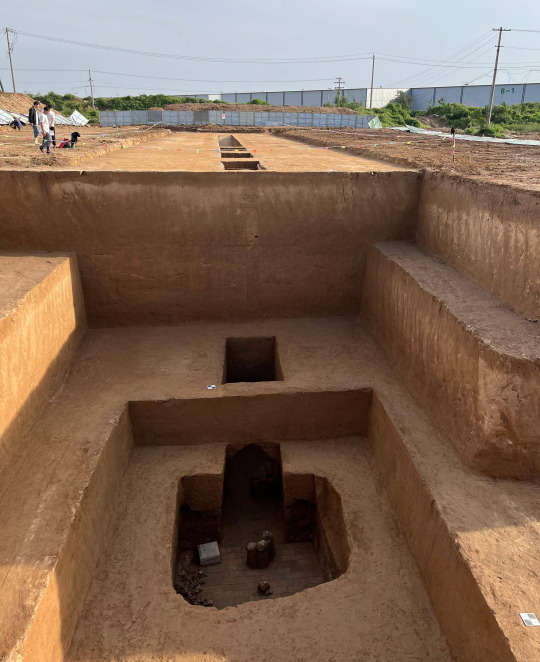
The newfound tomb near Xianyang is inscribed with an epitaph, written in characters painted with cinnabar, a red mineral form of mercuric sulfide. It describes Jue as "Duke of Lueyang," which was his official rank at the time of his death, and not as emperor.
According to the Shaanxi Academy of Archaeology, which is working on the excavations, the tomb was found in an area northwest of Xianyang that has many high-status tombs from that time.
A tomb belonging to Jue's younger brother was previously found nearby, while the tomb of yet another brother, Yuwen Yong — Emperor Wu of the Northern Zhou — is about 5 miles (8 km) to the east.
The newfound tomb is a single earthen chamber about 184 feet (56 meters) long and about 33 feet (10 m) deep.

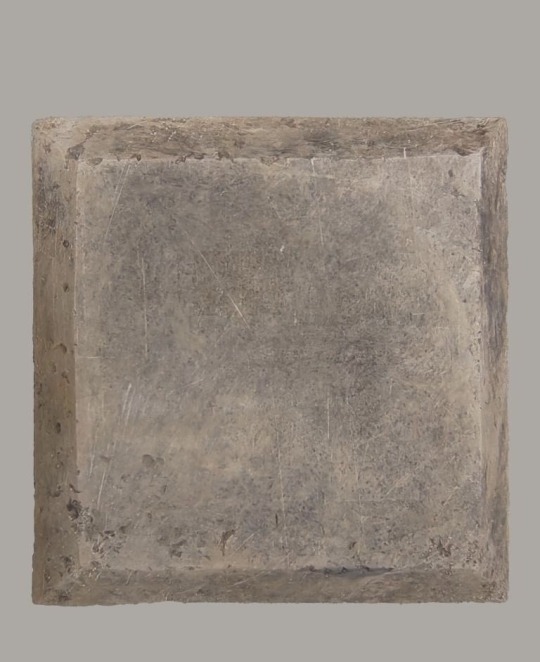
At some point, the tomb was disturbed by grave robbers, but the archaeologists unearthed 146 artifacts buried there as grave goods, including terra-cotta figurines and pottery, according to Xinhua.
Experts say the inscription on the tomb provides the first physical evidence of the political struggle that took place during the founding of the Northern Zhou dynasty, which had been described only in historical writings.
At that time, China was fractured into several kingdoms plagued by civil wars and political chaos — a period historians call the time of the Northern and Southern dynasties, between 420 and 589.
Historian Albert Dien, a professor emeritus of Chinese at Stanford University who was not involved with the tomb's discovery, told Live Science that Jue had been installed on the imperial throne by his cousin and guardian, the warlord Yuwen Hu.
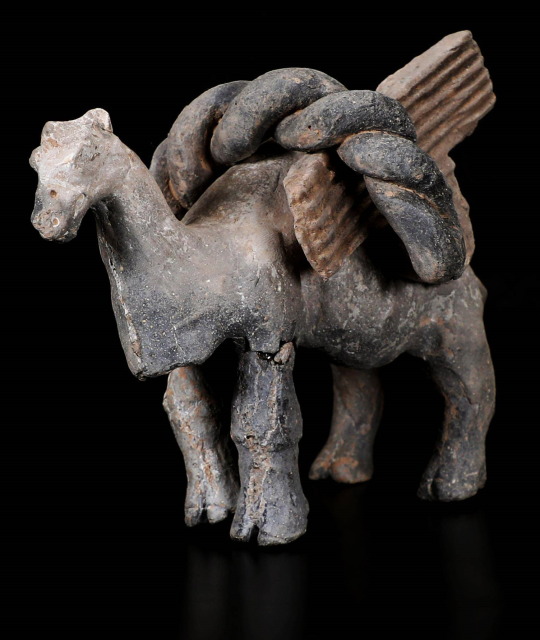


Jue was the son of Yuwen Tai, a powerful general of the Western Wei dynasty who died in 556, and with Hu's support, Jue ascended the throne in 557.
But Jue rebelled against control by Hu, so Hu had him deposed and executed a few months later, replacing him with another brother, Yuwen Yu — Emperor Ming.
Hu eventually poisoned Yu, and then controlled the Northern Zhou dynasty through puppet rulers until he was assassinated in 572 by a clique loyal to yet another brother, Yuwen Yong, who had become Emperor Wu.
Jue was proclaimed the first emperor of the Northern Zhao dynasty only after Yong dispatched Hu, roughly 37 years after Jue's death, Dien said. As a result, the inscription on the newfound tomb near Xianyang shows Jue had been buried as a duke when he died, and not as an emperor.
By Tom Metcalfe.
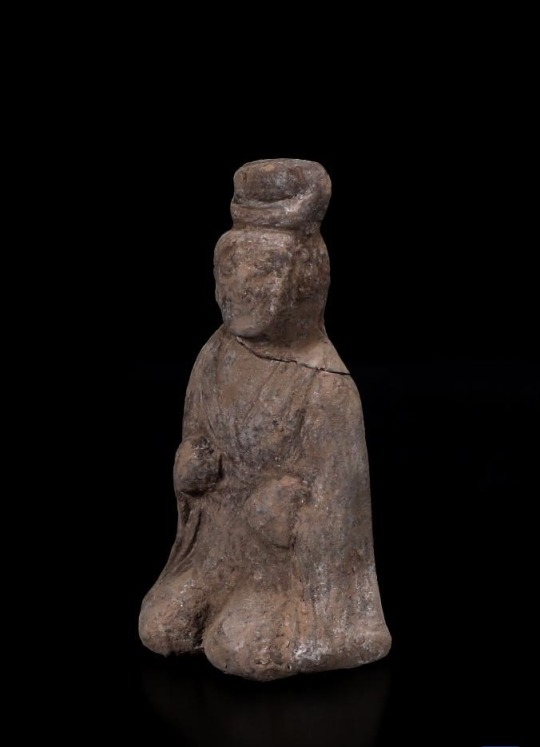


#Archaeologists Discover 1500-Year-Old Tomb of Ancient Emperor in China#Emperor Xiaomin#Yuwen Jue#Northern Zhou dynasty#ancient artifacts#archeology#archeolgst#history#history news#ancient history#ancient culture#ancient civilizations#ancient china#chinese history#chinese emperor#chinese art
49 notes
·
View notes
Text
Ancient DNA: Unraveling the Mystery of Chinese Emperor Wu
In an extraordinary leap in the field of genetic archaeology, researchers have brought to light the visage of Emperor Wu of the Northern Zhou dynasty, providing a direct glimpse into the appearance of a significant historical figure from 6th century China. Utilizing advanced ancient DNA extraction techniques, the team successfully reconstructed Emperor Wu’s face, offering insights not only into…

View On WordPress
0 notes
Text
youtube
Bodhisattva, April 2, 2012
Bodhisattva, probably Avalokiteshvara (Guanyin), Northern Qi dynasty, c. 550-60, Shanxi Province, China, sandstone with pigments, 13-3/4 feet / 419.1 cm high (Metropolitan Museum of Art, New York). Created by Beth Harris and Steven Zucker. Smarthistory
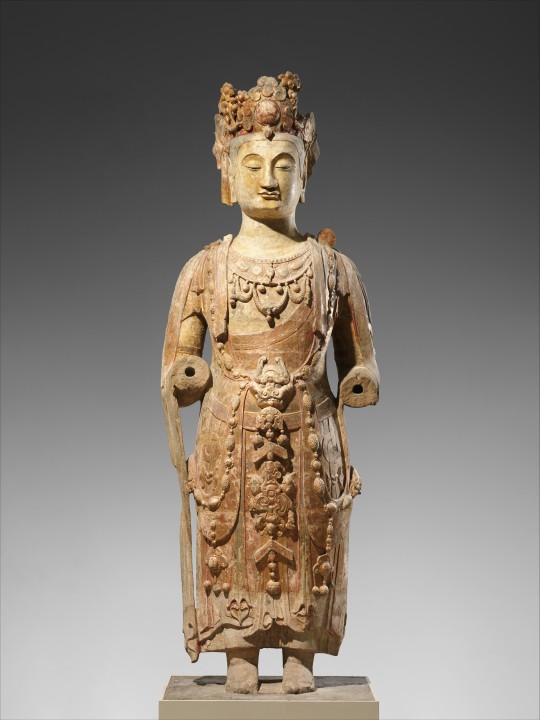
Bodhisattva, probably Avalokiteshvara (Guanyin), ca. 550–560
Northern Qi dynasty, China
Sandstone with pigment
H. 13 ft. 9 in. (419.1 cm); H. with base 14 ft. 9 in. (449.6 cm)
Large-scale sculptures of bodhisattvas wearing extraordinary jewelry epitomize stylistic and iconographic innovations in Chinese sculpture from the second half of the sixth century. The astonishing jeweled harness adorning this bodhisattva is made up of two long strands of pearl-like clusters and multifaceted beads. Some elements, such as the triangular pendants, have Chinese precedents. Others, such as the pearl cabochons, derive from Central Asian traditions. The appearance of such elaborately figural sculptures, which later became standard in Chinese Buddhist art, attests to a growing devotion to Avalokiteshvara in the second half of the sixth century. It is possible that the jewels refer to a passage in the Lotus Sutra in which the historical Buddha Shakyamuni and another bodhisattva extol Avalokiteshvara’s great compassion and presents him with a pearl necklace as a symbol of his benevolence. Collection of the Metropolitan Museum of Art
#iconography#figure#bodhisattva#Buddhism#avalokitesvara#guanyin#Chinese#sculpture#stone#sandstone#6th century#cultural amalgam#Northern Qi dynasty#Northern Zhou dynasty#northern and southern dynasties#the met#Metropolitan Museum of Art#Youtube
0 notes
Text
Is there somebody here who rlly likes Chinese History bc I'm really confused in the timeline here
#?#like#im seeing a bit ab the dinasties#and from multiple sources im seeing there was the shang dinasty and then zhou dinasty and then we shift to “imperial period”#whatever that means#and then we have the qin state that conquered every one else and did the qin dinasty (right?)#and then there is han dinasty#which apparently was interrupted by another dinasty in the middle?#and then smth happened and back to han#but then after the han dinasty (oriental/part 2) things get rlly confusing???#the dinasty names and order aint consistent in the different places im checking#theres like. jing dinasty ig? and then southern and northern dinasty#and then after there its just rlly inconsistent my sources cant seem to agree#china#ancient china#shang dynasty#zhou dynasty#qin dynasty#han dynasty#jin dynasty#history#chinese history#research tag#imperial china
1 note
·
View note
Text

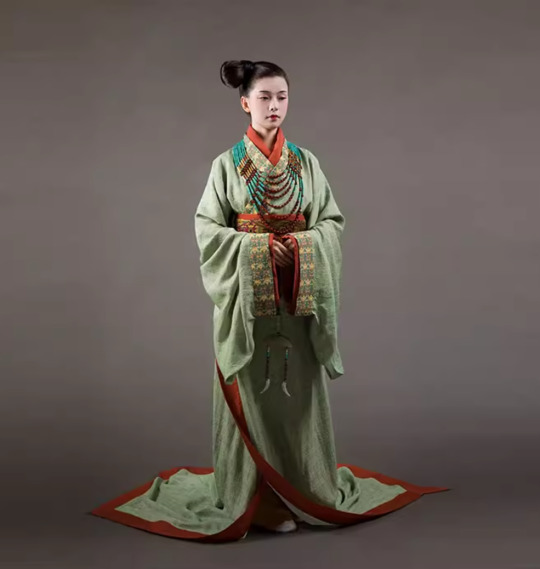
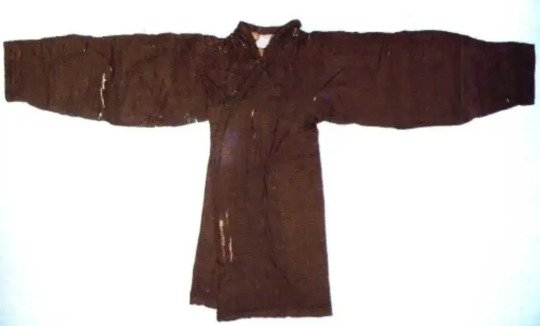

直裾战国袍 / Straight-edged Warring States robe: Distinguished by the excessive amount of fabric for the sleeves and the waist-to-floor straight edge, this style of Warring States robe was worn between the Warring States period and the Han Dynasty.
Warring States robes can usually be purchased in 2 lengths; - trailing on the floor (great for photos, awful for walking) - hemmed right at the floor (not as beautiful in photos, a lot easier for walking) Most stores selling this style of robes have skipped the extra piece of fabric between the sleeve and body, changing the entire drape of the fabric. Instead of it naturally opening at the front, this small change in the design causes the fabric to be completely closed at the front which makes walking without stepping on the fabric impossible (speaking from personal experience) T___T
==**==**==**==**==**==**==**==
Hanfu, the historical clothing of the Han people in China, has thousands of years of history. Since the 2000s, there has been a revival of Hanfu within China, with many Hanfu stores opening in the past two decades.
I first became aware that I could purchase Hanfu in 2021 and hoarded a bunch. Recently, I started digging more and more into the topic and realized that, while many of the Hanfu being sold are beautiful, they're not exactly true to the styles of Hanfu in the past. That's not to say they shouldn't be sold or worn, I'm not interested in gatekeeping what others wear, but I became intrigued by what exactly DID the historical Hanfu styles look like based on historical artefacts.
For my own interest, and for any others who might be interested, I'm going to try and do a series of the various Hanfu styles throughout the dynasties.
Chinese dynasties timeline for reference:
Shang Dynasty 商 (1300–1046 BC) Zhou Dynasty 周 (1046–256 BC) Western Zhou 西周 (1046–771 BC) Eastern Zhou 东周 >> Spring and Autumn Period 春秋 (770–481 BC) >> Warring States Period 战国 (481–221 BC) Qin Dynasty 秦 (221–207 BC) Han Dynasty 汉 >> Western Han 西汉 (206 BC–8 AD) >> Xin Dynasty 新 (9–23) >> Eastern Han 东汉 (25–220) Three Kingdoms 三国 (220–265) Jin Dynasty 晋 >> Western Jin 西晋 (265–316) >> Eastern Jin 东晋 (317–420) Northern and Southern Dynasties 南北朝 (420–589) Sui Dynasty 隋 (581–618) Tang Dynasty 唐 (618–907) Five Dynasties 五代 (907–960) Song Dynasty 宋 >> Northern Song 北宋 (960–1127) >> Southern Song 南宋 (1127–1279) Yuan Dynasty (Mongols) 元 (1271–1368) Ming Dynasty 明 (1368–1644) Qing Dynasty (Manchus) 清 (1644–1911) Republic of China 民国 (1912–1949) People's Republic of China 中华人民共和国 (1949-present)
414 notes
·
View notes
Text










The Cryptic Motif of “Three Hares with Conjoined Ears”
On the Heavenly Palace decorative patterns found in the Mogao Caves at Dunhuang from the late Northern dynasties are images with cryptic patterns, including Buddha's head, the Taotie beast, deer, animals copulating, three hares with conjoined ears, and also writings. This type of decorative pattern is cryptic and difficult to understand and may be closely related to the history of the popular Eastern iconology and divination philosophy from the Han and Wei dynasties and Emperor Wu of Northern Zhou's suppression of Buddhism. They are important references for studying the related history of this period.
#china#motif#three hares with conjoined ears#silk road#culture influenced by buddhism from ancient india#art#reference
1K notes
·
View notes
Note
hi emma!!!! i loved reading all your historical drs, have you ever considered being a writer omg!!! i was wondering if you could do one of ancient china or ancient korea! i’ve been setting up a nobility dr for each!
also, i started burning incense while i take baths, and omg if that’s even kind of like what it was in babylon im so thrilled for you. i feel like a princess.

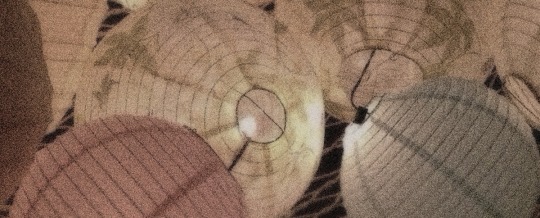

a guide on how to survive in ancient china.
hello, intrepid time traveler. i’m emma, your self-appointed shifting guidée and general lifeline as you hurl yourself into the vast, intricate, and utterly fascinating world of ancient china. this is not for the faint of heart, OK??? you are stepping into a civilisation spanning thousands of years, shifting (pun not intended) dynasties, and mind-bending customs. you need to be prepared. the great wall won’t save you, and confucius won’t be there to give you a pep talk. so i will.
your survival depends on understanding the nuances of daily life, from the silk-clad heights of imperial courts to the dusty roads of peasant villages. let’s get into it. how to dress, eat, navigate society, and, most importantly, how to not offend the wrong noble and end up in a very unfortunate situation (and by that, i mean executed).

꒰ 𝐝ynastic context . . .where are you in time?
ancient china isn’t just a single moment in history. it’s thousands of years of shifting rulers, laws, and customs. each period has its own political and cultural landscape, so research where you’re landing. here’s a quick guide to some of the major time periods you might find yourself in.
shang dynasty ( 1600 – 1046 bce ) : the bronze age, oracle bones, and human sacrifices. if you’re here, be careful. early china was intense.
zhou dynasty ( 1046 – 256 bce ) : the age of confucius, the mandate of heaven, and the rise of philosophy.
qin dynasty ( 221 – 206 bce ) : the first emperor, legalist rule, and the construction of the great wall. harsh punishments, so keep your head down.
han dynasty ( 206 bce – 220 ) : the golden age of china. silk road trade, confucian ideals, and thriving arts and sciences.
tang dynasty ( 618 – 907 ) : the height of chinese cultural brilliance. poetry, tea, and flourishing trade. if you’re here, congratulations. you’ve landed in one of the best times.
song dynasty ( 960 – 1279 ) : economic prosperity, gunpowder, and great advancements in technology. just watch out for the mongols.

┊
꒰ 𝐰hat to wear.
fabric and style : if you’re nobility, you’ll be wearing silk robes with intricate embroidery. if you’re a commoner, it’s hemp or cotton tunics and pants. men and women both wear hanfu, the traditional robe-like attire with wide sleeves and layered skirts. hair : hair is a BIG deal. long, neatly styled hair is a sign of respectability. women will have their hair pinned up with elaborate ornaments, while men tie theirs in a topknot or wear hats. colours : certain colours indicate status. yellow is reserved for the emperor, so do not wear it unless you want serious trouble. shoes : cloth or leather shoes for commoners, embroidered silk shoes for the wealthy. lotus shoes (for bound feet) exist but are not universal.
❛ pro tip from your travel guide ! clothes often reflect rank, so don’t dress above your station unless you want to get called out.

┊
꒰ 𝐡ygiene and personal care.
bathing : hot baths were a thing, especially for the wealthy, but commoners bathed in rivers or public bathhouses. soap existed, but herbal infusions were more common.
teeth cleaning : chew sticks made of aromatic wood or herbal pastes.
perfume and skincare : scented powders and oils made from flowers and herbs were common, especially among noblewomen.
toilets : public latrines existed, often near marketplaces. rich households had chamber pots.

┊
꒰ 𝐟ood and what you'll be eating.
staple foods : rice (southern china), millet and wheat (northern china), vegetables, and tofu.
meat or fish : pork was the most common, followed by chicken and duck. beef was rare due to buddhist influence.
street food : dumplings, noodles, and grilled skewers were available in bustling markets.
tea : a must-have, especially in later dynasties. if you’re in tang or song china, tea culture is booming.
chopsticks : learn how to use them. forks are not an option.

┊
꒰ 𝐦oney and shopping.
ancient china used copper coins with square holes in the centre, strung together for convenience. paper money appears in the song dynasty.
everything from silk to fresh produce to exotic spices can be found in bustling markets. bargaining is expected, so don’t accept the first price.
trade : silk, porcelain, and tea are major commodities. if you want to make money, consider trading luxury goods.

┊
꒰ 𝐬ocial class.
emperors or nobility : untouchable. bow deeply, avoid direct eye contact, and NEVER question them. scholars and officials : the ruling class of confucian-trained bureaucrats. respect them. merchants : despite their wealth, merchants were looked down upon as lower-class (confucian ideals valued scholars over businessmen). peasants and labourers : the majority of the population, hardworking and tied to their land. if you're asking what were women’s roles, it varies by dynasty, but generally, women are expected to be modest, obedient, and skilled in household arts.
❛ pro tip from your travel guide ! bowing is essential. use honourifics, speak respectfully, and never address a superior informally.

┊
꒰ 𝐩ersonal safety.
crime and punishment : punishments are often brutal, especially under legalist rule (think qin dynasty). avoid breaking the law.
superstitions : witchcraft accusations or defying social norms can be dangerous, especially for women.
if you're travelling, roads are dangerous, with bandits common in rural areas. if possible, travel with an armed escort.
military : avoid battles unless you’re a trained warrior. war is frequent between dynasties and neighbouring states.

┊
꒰ 𝐟inal tips for a successful integration.
please.....learn basic mandarin (or classical chinese). speaking the language is key. written chinese changes over time, so be aware of your era.
adopt confucian values, such as respect for elders, duty, and harmony are essential cultural pillars.
stay in your lane, because blending in is survival. don’t attract unnecessary attention.
rituals, festivals, and ancestral worship are vital parts of daily life. follow traditions.
if all else fails, claim to be a wandering scholar or lost noble (but tread carefully).

congratulations!!!! you now have the basic knowledge needed to navigate ancient china without causing a diplomatic incident. or worse, getting yourself executed. step lightly, speak wisely, and drink your tea politely. happy shifting, time traveler!!!!!
( p.s., the pretty dividers were inspired by the ever-so-lovely @solanasreality and i think @elysian-fawn 's beautiful creativity possessed as i edited this. so. )
#asks#emmas vampire dr#reality shift#desired reality#realityshifting#shifting community#reality shifting#shifting motivation#emma motivates#shifting#shifting realities#shifting blog#marauders shifting#shifting antis dni#reality shifting community#shifting advice#shifting ideas#shifting diary#shifting help#shifting reality#shifting script#shifting tips#shifting to desired reality#shifting thoughts#shiftingrealities#shifting consciousness#anti shifters dni#shifters
215 notes
·
View notes
Text
i’m reading the wikipedia page for emperor xuan of northern zhou and the whole time i’ve got my hand pressed to my mouth and i’m alternating between saying “he’s so normal” and “why would he do that? why would he do that??” in tones of breathless awe. he’s one of those really special emperors you only get once a dynasty, for obvious reasons
80 notes
·
View notes
Text
[Hanfu · 漢服]The relationship between women in history is not just love rivals,
“but also thousands of years later, everyone knows that it is me and you.”
Let's get to know about them/她们 in China history.
1.【Han Dynasty】:Princess Jieyou (解忧公主) & Feng Liao (馮嫽)
Princess Jieyou (Chinese: 解忧公主; 121 BC – 49 BC), born Liu Jieyou (Chinese: 刘解忧), was a Chinese princess sent to marry the leader of the Wusun kingdom as part of the Western Han Chinese policy of heqin(和亲).
As the granddaughter of the disgraced Prince Liu Wu (劉戊) who had taken part in the disastrous Rebellion of the Seven States,her status was low enough that she was sent to replace Princess Liu Xijun (劉細君) after her untimely death and marry the Wusun king Cunzhou (岑陬).
Jieyou lived among the Wusun for fifty years and did much work to foster relations between the surrounding kingdoms and the Han. She was particularly reliant upon her attendant, Feng Liao, whom she dispatched as an emissary to Wusun kingdoms and even to the Han Court. She faced opposition from pro-Xiongnu members of the Wusun royalty, particularly Wengguimi’s Xiongnu wife. When word came that the Xiongnu planned to attack Wusun, she convinced her husband to send for aid from the Han Emperor. Emperor Wu of Han sent 150,000 cavalrymen to support the Wusun forces and drive back the Xiongnu.
In 51 BCE at the age of 70, Jieyou asked to be allowed to retire and return to the Han. Emperor Xuan of Han agreed and had her escorted back to Chang'an where she was welcomed with honor. She was given a grand palace with servants usually reserved for princesses of the imperial family. In 49 BCE, Jieyou died peacefully.
Feng Liao (馮嫽)
Feng Liao (馮嫽) was China's first official female diplomat,[citation needed] who represented the Han dynasty to Wusun (烏孫), which was in the Western Regions. It was a practice for the Imperial Court to foster alliances with the northern tribes via marriage, and two Han princesses had married Wusun kings.
Feng Liao was the maidservant of Princess Jieyou (解憂公主), who was married off to a Wusun king. Feng herself later married an influential Wusun general, whose good standing with Prince Wujiutu (烏就屠) of the kingdom later proved beneficial to the Han dynasty.
When Prince Wujiutu seized the throne of Wusun in 64 BC, after his father died, there was fear in the Imperial Court of Han that Wujiutu, whose mother was Xiongnu, would allow Wusun to become Xiongnu's vassal.
Zheng Ji, Governor of the Western Regions, recalled that Feng Liao had married into Wusun and with her familiarity of the Wusun customs, she was a prime candidate to persuade Wujiutu to ally his kingdom with Han. Wujiutu acceded and Emperor Xuan of Han (漢宣帝) sent for Feng. He praised her for her judgement and diplomacy, and appointed her as the official envoy to Wusun.
Wujiutu was conferred the title "Little King of Wusun" while his brother, the son by a Han princess, was named "Great King of Wusun". Wusun was divided between the two kings and tensions in that region were eased.
※Xiongnu: Xiongnu: A nomadic tribe that has occupied northern China for a long time. Later it gradually became a state. It harassed the borders of the Han Dynasty for a long time and robbed supplies.
------
With their efforts, the Wusun Kingdom gradually tended to support the Han Dynasty, and the Xiongnu's defeat in China also began.
------
2.【Tang Dynasty】:Shangguan Wan'er(上官婉儿)&Princess Taiping (太平公主)
Shangguan Wan'er/上官婉儿 (664 – 21 July 710) was a Chinese politician, poet, and imperial consort of the Wu Zhou and Tang dynasties. Described as a "female prime minister,"Shangguan rose from modest origins as a palace servant to become secretary and leading advisor to Empress Wu Zetian of Zhou. Under Empress Wu, Shangguan exercised responsibility for drafting imperial edicts and earned approbation for her writing style. She retained her influence as consort to Wu's son and successor, Emperor Zhongzong of Tang, holding the imperial consort rank of Zhaorong (昭容). Shangguan was also highly esteemed for her talent as a poet.Shangguan was also highly esteemed for her talent as a poet. In 710, after Emperor Zhongzong's death, Shangguan was killed during a palace coup that ended the regency of Empress Dowager Wei.
Princess Taiping (太平公主)lit. "Princess of Great Peace", personal name unknown, possibly Li Lingyue (李令月) (after 662 – 2 August 713) was a royal princess and prominent political figure of the Tang dynasty and her mother Wu Zetian's Zhou dynasty. She was the youngest daughter of Wu Zetian and Emperor Gaozong and was influential during the reigns of her mother and her elder brothers Emperor Zhongzong and Emperor Ruizong (both of whom reigned twice), particularly during Emperor Ruizong's second reign, when for three years until her death, she was the real power behind the throne.
She is the most famous and influential princess of the Tang dynasty and possibly in the whole history of China thanks to her power, ability and ambition. She was involved in political difficulties and developments during the reigns of her mother and brothers. Indeed, after the coup against Empress Dowager Wei, she became the real ruler of Tang. During the reign of Emperor Ruizong, she was not restricted by anything, the emperor issued rulings based on her views and the courtiers and the military flattered her and majority from every civil and military class joined her faction, so her power exceeded that of the emperor.
Eventually, however, a rivalry developed between her and her nephew, Emperor Ruizong's son, Crown Prince Li Longji. Both of them were hostile in power-sharing and they fought for the monopoly over power. After Emperor Ruizong yielded the throne to Li Longji (as Emperor Xuanzong) in 712, the conflict came to the political forefront, and openly, the court became a manifestation of conspiracy rather than the administration of the empire; in 713, Emperor Xuanzong, according to historical records, believing that she was planning to overthrow him, acted first, executing a large number of her powerful allies and forcing her to commit suicide.
------
The relationship between Shangguan Wan'er and Princess Taiping has always been written as "enemies" in official history, but with the phrase "千年万岁,椒花颂声", their friendship that has been buried for thousands of years was revealed.
The"千年万岁,椒花颂声" sentence comes from the epitaph written by Princess Taiping for Shangguan Wan'er. The original text is: "潇湘水断,宛委山倾,珠沉圆折,玉碎连城。甫瞻松槚,静听坟茔,千年万岁,椒花颂声”
Translation: Now that you are far away, the sky and the earth will lose their color. I'm afraid that all I can do in the future is to sit and look at the tea tree in front of your tomb. Maybe I can hear your voice again when I stand within an inch of the tomb. But this is a delusion after all, a quiet tomb, no beautiful face, a empty place of death. I hope that in a thousand or ten thousand years, there will still be people like me who remember you.
------
3.【Late Qing Dynasty】:Lü Bicheng(呂碧城) & Qiu Jin (秋瑾)
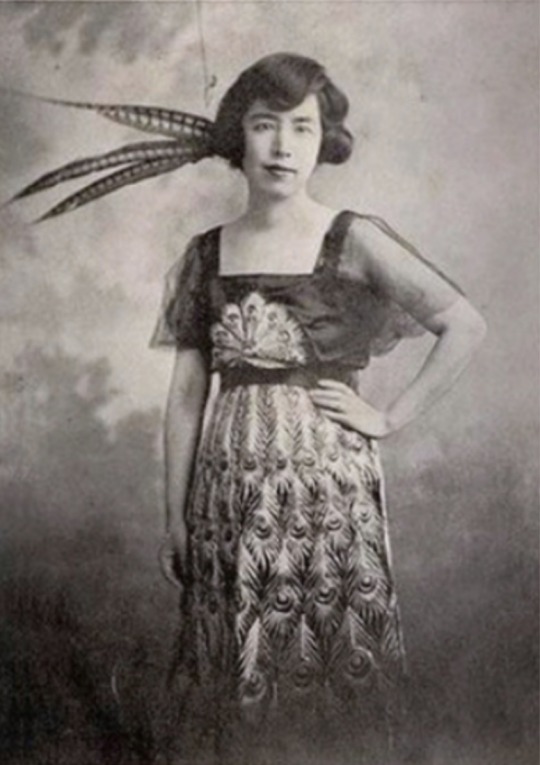
Lü Bicheng(呂碧城)also known as Alice Pichen Lee(1883–1943) was a Chinese writer, activist, newspaper editor, poet and school founder. She has been mentioned as one of the top four women in literature from the early Republic of China.
When she was four, her father retired to Lu'an, Anhui. She lived a life of comfort until the age of 12, when her father died in 1895. Because Lü Fengqi had no male heir, relatives of the Lü lineage contested for his inheritance, and Yan Shiyu and her four daughters were forced to move to Lai'an County to live with her natal family. When she was nine, Lü Bicheng was betrothed to a Wang family, but as her own family fortune declined, the Wang family broke off the marriage contract, giving the young Bicheng the stigma of a "rejected woman". The resulting emotional scar is often considered a major factor in her later decision to never marry.[8] Her widowed mother and the Lü girls were not well treated at the Yan family in rural Anhui. When Lü was 15 or 16, Yan Shiyu sent her to live with her maternal uncle Yan Langxuan (嚴朗軒), who was the salt administrator in Tanggu, the port city outside the northern metropolis of Tianjin. Her sister Huiru also joined her later.
During her stay in Tanggu, Qing China went through the tumultuous period of the failed Hundred Days' Reform of 1898, which brought about increasing awareness of women's education, and the Boxer Rebellion of 1900. In 1904, Mrs. Fang, the wife of her uncle's secretary, invited Lü Bicheng to visit a girls' school in Tianjin, but her uncle prevented her from going and severely reprimanded her. The next day, she ran away from her uncle's home, and took the train to Tianjin with no money or luggage. She wrote a letter to Mrs. Fang, who was staying at the dormitory of the Ta Kung Pao newspaper. Ying Lianzhi, the Catholic Manchu nobleman who founded the newspaper, read the letter and was so impressed by it that he made her an assistant editor. Lü Bicheng wrote a "progressive" ci that she had previously written, set to "A River Full of Red" ("Manjianghong") usually used to express heroic emotions. Ying transcribed the whole song in her diary and published it in L'impartial two days later. At the time, it was sensational for a woman to write for an influential national newspaper such as Ta Kung Pao. She was 21 years old. She used Ta Kung Pao to promote feminism and became a well-known figure.
Lü's ci poetry was published in the newspaper and it was very well received. She was the chief editor of the newspaper from 1904 to 1908. In 1904 she decided to improve education for girls. She had published her thoughts on women's rights and the general editor of the newspaper introduced her to Yan Fu who was an advocate for Western ideas. The Beiyang Women's Normal School was established that same year. At 23 Lü took on the job of principal of the school she had founded two years before. At first this school found it difficult to find girls who qualified for secondary education and students were brought in from Shanghai to make up the numbers.
Lü knew the revolutionary Qiu Jin and they had similar objectives but Lü did not join her in Japan when she was invited as she was unsure whether women should meddle in politics. She was then chosen to be secretary to Yuan Shikai, one of the most powerful people in China. When he set out to declare himself emperor of China she left, like many of his followers, and abandoned him.
--

Qiu Jin (秋瑾)8 November 1875 – 15 July 1907,was a Chinese revolutionary, feminist, and writer.Her sobriquet name is Jianhu Nüxia (Chinese: 鑑湖女俠 lit. 'Woman Knight of Mirror Lake').
Qiu was born into a wealthy family. Her grandfather worked in the Xiamen city government and was responsible for the city's defense. Zhejiang province was famous for female education, and Qiu Jin had support from her family when she was young to pursue her educational interests. Her father, Qiu Shounan, was a government official and her mother came from a distinguished literati-official family. Qiu Jin's wealthy and educated background, along with her early exposure to political ideologies were key factors in her transformation to becoming a female pioneer for the woman's liberation movement and the republican revolution in China.
In the early 1900s, Japan had started to experience western influences earlier than China. As to not fall behind, the Qing government sent many elites to learn from the Japanese. Qiu Jin was one of these elites that got the chance to study overseas. After studying in a women's school in Japan, Qiu returned to China to participate in a variety of revolutionary activities; and through her involvement with these activities, it became clear how Qiu wanted others to perceive her. Qiu called herself 'Female Knight-Errant of Jian Lake' — the role of the knight-errant, established in the Han dynasty, was a prototypically male figure known for swordsmanship, bravery, faithfulness, and self-sacrifice — and 'Vying for Heroism'
Qiu Jin had her feet bound and began writing poetry at an early age. With the support from her family, Qiu Jin also learned how to ride a horse, use a sword, and drink wine—activities that usually only men were permitted to learn at the time.In 1896 Qiu Jin got married. At the time she was only 21, which was considered late for a woman of that time. Qiu Jin's father arranged her marriage to Wang Tingchun, the youngest son of a wealthy merchant in Hunan province. Qiu Jin did not get along well with her husband, as her husband only cared about enjoying himself.While in an unhappy marriage, Qiu came into contact with new ideas. The failure of her marriage affected her decisions later on, including choosing to study in Japan.
While still in Tokyo, Qiu single-handedly edited a journal, Vernacular Journal (Baihua Bao). A number of issues were published using vernacular Chinese as a medium of revolutionary propaganda. In one issue, Qiu wrote A Respectful Proclamation to China's 200 Million Women Comrades, a manifesto within which she lamented the problems caused by bound feet and oppressive marriages. Having suffered from both ordeals herself, Qiu explained her experience in the manifesto and received an overwhelmingly sympathetic response from her readers. Also outlined in the manifesto was Qiu's belief that a better future for women lay under a Western-type government instead of the Qing government that was in power at the time. She joined forces with her cousin Xu Xilin and together they worked to unite many secret revolutionary societies to work together for the overthrow of the Qing dynasty.
Between 1905 and 1907, Qiu Jin was also writing a novel called Stones of the Jingwei Bird in traditional ballad form, a type of literature often composed by women for women audiences. The novel describes the relationship between five wealthy women who decide to flee their families and the arranged marriages awaiting them in order to study and join revolutionary activities in Tokyo. Titles for the later uncompleted chapters suggest that the women will go on to talk about “education, manufacturing, military activities, speechmaking, and direct political action, eventually overthrowing the Qing dynasty and establishing a republic” — all of which were subject matters that Qiu either participated in or advocated for.
Life after returning to China
Qiu Jin was known as an eloquent orator who spoke out for women's rights, such as the freedom to marry, freedom of education, and abolishment of the practice of foot binding. In 1906 she founded China Women's News (Zhongguo nü bao), a radical women's journal with another female poet, Xu Zihua in Shanghai. They published only two issues before it was closed by the authorities. In 1907, she became head of the Datong school in Shaoxing, ostensibly a school for sport teachers, but really intended for the military training of revolutionaries[citation needed]. While teaching in Datong school, she kept secret connection with local underground organization—The Restoration Society. This organization aimed to overthrow the Manchu government and restore Chinese rule.
Death
In 1907, Xu Xilin, Qiu’s friend and the Datong school’s co-founder was executed for attempting to assassinate his Manchu superior. In the same year, the authorities arrested Qiu at the school for girls where she was the principal. She was tortured but refused to admit her involvement in the plot. Instead the authorities used her own writings as incrimination against her and, a few days later, she was publicly beheaded in her home village, Shanyin, at the age of 31. Her last written words, her death poem, uses the literal meaning of her name, Autumn Gem, to lament of the failed revolution that she would never see take place:
秋風秋雨愁煞人 (Autumn wind, autumn rain — they make one die of sorrow)
After Qiu Jin was killed, no one dared to collect her body. Lu Bicheng endured her grief and took great risks to bury her friend. The guarding Qing army learned that the woman who came to collect the corpse was Lu Bicheng, who was famous in China, and they had no choice but to do anything.
Qiu Jin's death caused Lu Bicheng to lose a rare confidant in life. She wrote many poems in memory of Qiu Jin, recalling this like-minded friend.
Later, Lü Bicheng wrote "The Biography of the Revolutionary Heroine Qiu Jin" in English, which was published in newspapers in New York, Chicago and other places in the United States. It caused a great response and not only made many people in the world know about Qiu Jin's legendary story, but also published it in newspapers in New York and Chicago. It also makes people understand the darkness and corrupt social status quo of the Qing Dynasty. Lu Bicheng used a pen of her own to record her friendship with Qiu Jin, and also fulfilled her promise to Qiu Jin to respond with the "battle of words"
————————
📸Video & 🧚🏻 Model:@荷里寒 & @阿时Ashi_
🔗Weibo:https://weibo.com/3618951560/NEZZnpQRq
————————
#chinese hanfu#china history#woman power#woman in history#hanfu#hanfu accessories#hanfu_challenge#chinese traditional clothing#china#chinese#han dynasty#tang dynasty#late qing dynasty#feminism#revolution#漢服#汉服#中華風#girl power#hanfu girl
395 notes
·
View notes
Text









Relic Prohibited From Displaying Abroad: Northern Wei Dynasty Painting
Painted screen covered with vermilion lacquer from the tomb of Sima Jinlong (司馬金龍).
The outlines are finely drawn in black ink. A dazzling riot of colors distinguishes this specimen from those of previous centuries.
The painting illustrates narratives about female virtues and filial piety from Han dynasty Liu Xiang's (劉向) Confucian classic “Biography of Exemplary Women” (列女傳).
The top section from the well-preserved part in the photo depicts Emperor Shun's story of filial piety.
The second represents Three Queens of Zhou dynasty – Tai Jiang, Tai Ren and Tai Shi – exemplary mothers and wives (whose historicity remains in doubt) included in later collections of moral precepts.
The third section portrays Lushi Chunjiang and Chunjiang’s daughter.
The bottom one illustrates the episode when the Consort Ban (班婕妤) refused to accompany the emperor in a palanquin so as not to distract him from the thoughts about the state welfare.
The screen was unearthed in Shijiazhai (石家寨) village, Datong, Shanxi in 1965. It is surprising that many precious artifacts remained in the burial pit, despite repeated plundering. We can chalk it up to the ignorance of the thieves.
The board is 82 cm long, 40 cm wide and 2.5 cm thick. The two pieces of the lacquer-painted screen are connected by mortise and tenon joint.
Due to its exceptional fragility and value, the panel is not allowed to be exhibited abroad. Despite all the museum care, the second part of the diptych is not so well-preserved. The tomb has been repeatedly flooded over the centuries, and the dampness has taken its toll. The vermilion screen is stored in Datong Museum (大同市博物館), Shanxi. The original is rare on display for several days only, the rest of the time it is replaced by a replica. Pictured is the original.
#ancient china#chinese culture#chinese art#chinese history#chinese painting#painting miniatures#painting on wood#Northern Wei dynasty#lacquer#lacquerware#ancient tomb#tomb art#vermilion#artifact#unique#relic#han dynasty#burial site#burial#chinese customs
71 notes
·
View notes
Text
April 14, Xi'an, China, Shaanxi History Museum, Qin and Han Dynasties Branch (Part 3 – Innovations and Philosophies):
(Edit: sorry this post came out so late, I got hit by the truck named life and had to get some rest, and this post in itself took some effort to research. But anyway it's finally up, please enjoy!)
A little background first, because this naming might lead to some confusions.....when you see location adjectives like "eastern", "western", "northern", "southern" added to the front of Zhou dynasty, Han dynasty, Song dynasty, and Jin/晋 dynasty, it just means the location of the capital city has changed. For example Han dynasty had its capital at Chang'an (Xi'an today) in the beginning, but after the very brief but not officially recognized "Xin dynasty" (9 - 23 AD; not officially recognized in traditional Chinese historiography, it's usually seen as a part of Han dynasty), Luoyang became the new capital. Because Chang'an is geographically to the west of Luoyang, the Han dynasty pre-Xin is called Western Han dynasty (202 BC - 8 AD), and the Han dynasty post-Xin is called Eastern Han dynasty (25 - 220 AD). As you can see here, in these cases this sort of adjective is simply used to indicate different time periods in the same dynasty.
Model of a dragonbone water lift/龙骨水车, Eastern Han dynasty. This is mainly used to push water up to higher elevations for the purpose of irrigation:
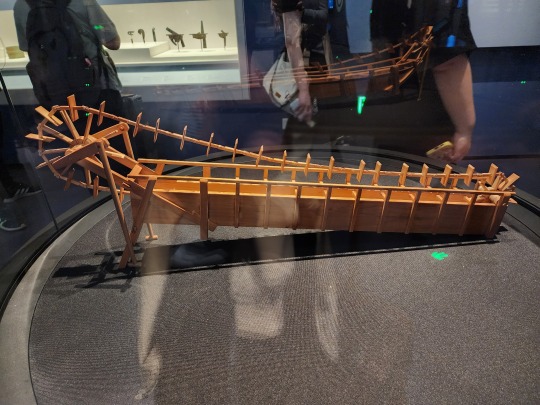
Model of a water-powered bellows/冶铁水排, Eastern Han dynasty. Just as the name implies, as flowing water pushes the water wheel around, the parts connected to the axle will pull and push on the bellows alternately, delivering more air to the furnace for the purpose of casting iron.
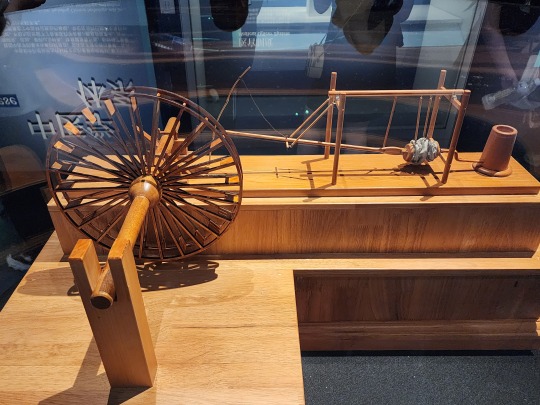
The Nine Chapters on the Mathematical Art/《九章算术》, Fangcheng/方程 chapter. It’s a compilation of the work of many scholars from 10 th century BC until 2 nd century AD, and while the earliest authors are unknown, it has been edited and supplemented by known scholars during Western Han dynasty (also when the final version of this book was compiled), then commented on by scholars during Three Kingdoms period (Kingdom of Wei) and Tang dynasty. The final version contains 246 example problems and solutions that focus on practical applications, for example measuring land, surveying land, construction, trading, and distributing taxes. This focus on practicality is because it has been used as a textbook to train civil servants. Note that during Han dynasty, fangcheng means the method of solving systems of linear equations; today, fangcheng simply means equation. For anyone who wants to know a little more about this book and math in ancient China, here’s an article about it. (link goes to pdf)

Diagram of a circle in a right triangle (called “勾股容圆” in Chinese), from the book Ceyuan Haijing/《测圆海镜》 by Yuan-era mathematician Li Ye/李冶 (his name was originally Li Zhi/李治) in 1248. Note that Pythagorean Theorem was known by the name Gougu Theorem/勾股定理 in ancient China, where gou/勾 and gu/股 mean the shorter and longer legs of the right triangle respectively, and the hypotenuse is named xian/弦 (unlike what the above linked article suggests, this naming has more to do with the ancient Chinese percussion instrument qing/磬, which is shaped similar to a right triangle). Gougu Theorem was recorded in the ancient Chinese mathematical work Zhoubi Suanjing/《周髀算经》, and the name Gougu Theorem is still used in China today.
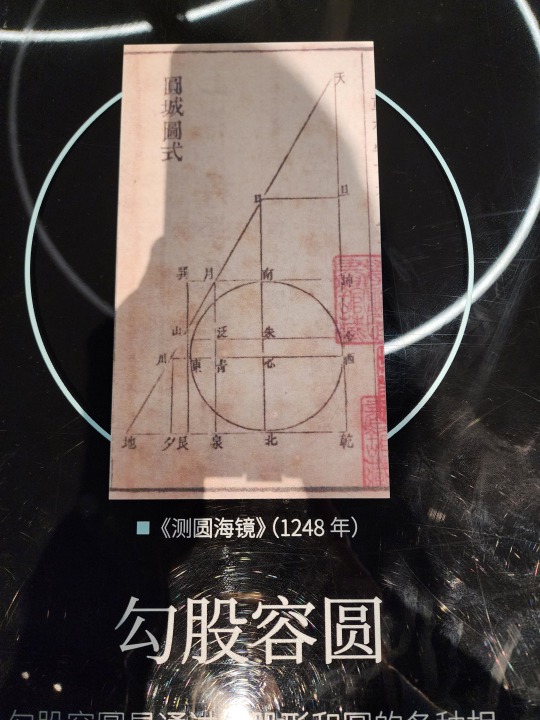
Diagram of the proof for Gougu Theorem in Zhoubi Suanjing. The sentence on the left translates to "gou (shorter leg) squared and gu (longer leg) squared makes up xian (hypotenuse) squared", which is basically the equation a² + b² = c². Note that the character for "squared" here (mi/幂) means "power" today.

This is a diagram of Zhang Heng’s seismoscope, called houfeng didong yi/候风地动仪 (lit. “instrument that measures the winds and the movements of the earth”). It was invented during Eastern Han dynasty, but no artifact of houfeng didong yi has been discovered yet, this is presumably due to constant wars at the end of Eastern Han dynasty. All models and diagrams that exist right now are what historians and seismologists think it should look like based on descriptions from Eastern Han dynasty. This diagram is based on the most popular model by Wang Zhenduo that has an inverted column at the center, but this model has been widely criticized for its ability to actually detect earthquakes. A newer model that came out in 2005 with a swinging column pendulum in the center has shown the ability to detect earthquakes, but has yet to demonstrate ability to reliably detect the direction where the waves originate, and is also inconsistent with the descriptions recorded in ancient texts. What houfeng didong yi really looks like and how it really works remains a mystery.
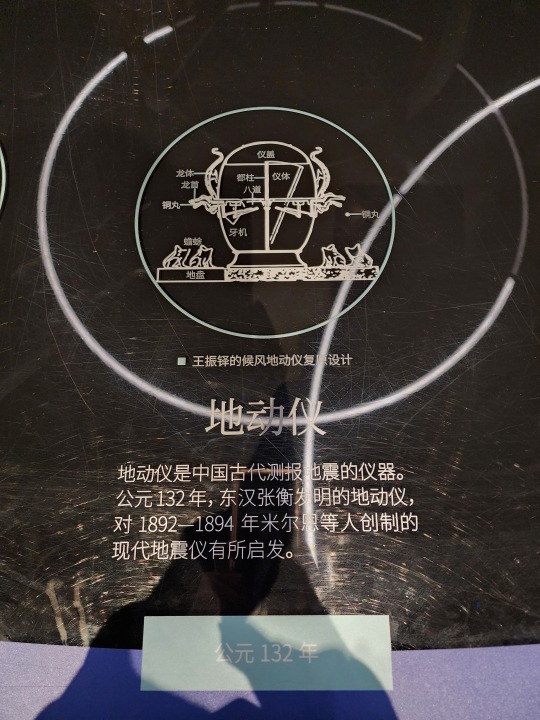
Xin dynasty bronze calipers, the earliest sliding caliper found as of now (not the earliest caliper btw). This diagram is the line drawing of the actual artifact (right).
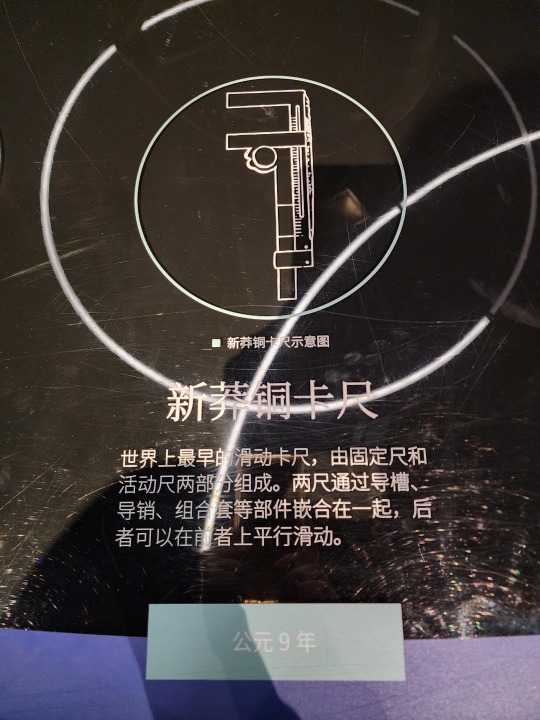

Ancient Chinese "Jacquard" loom (called 提花机 or simply 花机 in Chinese, lit. "raise pattern machine"), which first appeared no later than 1st century BC. The illustration here is from the Ming-era (1368 - 1644) encyclopedia Tiangong Kaiwu/《天工开物》. Basically it's a giant loom operated by two people, the person below is the weaver, and the person sitting atop is the one who controls which warp threads should be lifted at what time (all already determined at the designing stage before any weaving begins), which creates patterns woven into the fabric. Here is a video that briefly shows how this type of loom works (start from around 1:00). For Hanfu lovers, this is how zhuanghua/妆花 fabric used to be woven, and how traditional silk fabrics like yunjin/云锦 continue to be woven. Because it is so labor intensive, real jacquard silk brocade woven this way are extremely expensive, so the vast majority of zhuanghua hanfu on the market are made from machine woven synthetic materials.
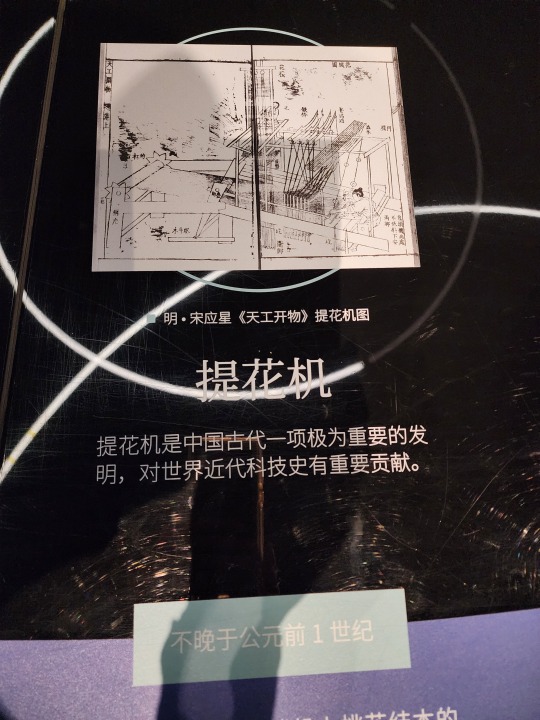
Chinese purple is a synthetic pigment with the chemical formula BaCuSi2O6. There's also a Chinese blue pigment. If anyone is interested in the chemistry of these two compounds, here's a paper on the topic. (link goes to pdf)

A list of common colors used in Qin and Han dynasties and the pigments involved. White pigment comes from chalk, lead compounds, and powdered sea shells; green pigment comes from malachite mineral; blue pigment usually comes from azurite mineral; black comes from pine soot and graphite; red comes from cinnabar; ochre comes from hematite; and yellow comes from realgar and orpiment minerals.
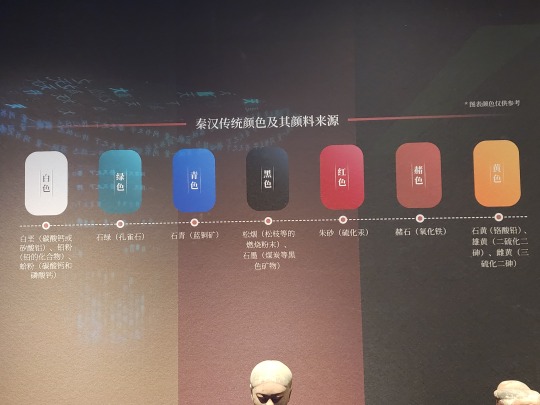
Also here are names of different colors and shades during Han dynasty. It's worth noting that qing/青 can mean green (ex: 青草, "green grass"), blue (ex: 青天, "blue sky"), any shade between green and blue, or even black (ex: 青丝, "black hair") in ancient Chinese depending on the context. Today 青 can mean green, blue, and everything in between.
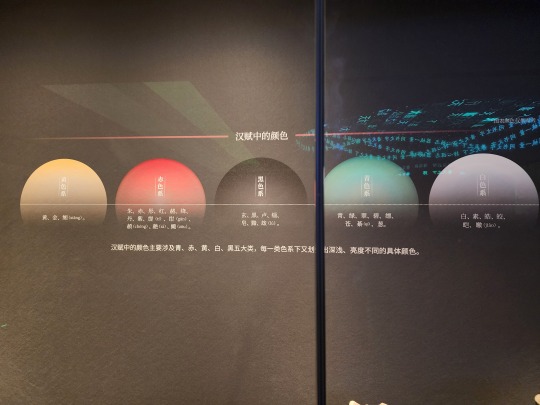
Western Han-era bronze lamp shaped like a goose holding a fish in its beak. This lamp is interesting as the whole thing is hollow, so the smoke from the fire in the lamp (the fish shaped part) will go up into the neck of the goose, then go down into the body of the goose where there's water to catch the smoke, this way the smoke will not be released to the surrounding environment. There are also other lamps from around the same time designed like this, for example the famous gilt bronze lamp that's shaped like a kneeling person holding a lamp.
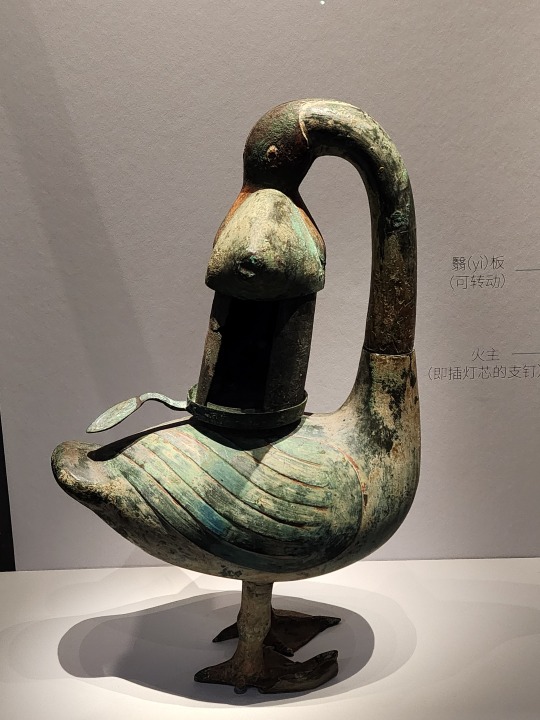

Part of a Qin-era (?) clay drainage pipe system:

A list of canals that was dug during Warring States period, Qin dynasty, and pre-Emperor Wu of Han Han dynasty (475 - 141 BC). Their purposes vary from transportation to irrigation. The name of the first canal on the list, Hong Gou/鸿沟, has already become a word in Chinese language, a metaphor for a clear separation that cannot be crossed (ex: 不可逾越的鸿沟, meaning "a gulf that cannot be crossed").

Han-era wooden boat. This boat is special in that its construction has clear inspirations from the ancient Romans, another indication of the amount of information exchange that took place along the Silk Road:

A model that shows how the Great Wall was constructed in Qin dynasty. Laborers would use bamboo to construct a scaffold (bamboo scaffolding is still used in construction today btw, though it's being gradually phased out) so people and materials (stone bricks and dirt) can get up onto the wall. Then the dirt in the middle of the wall would be compressed into rammed earth, called hangtu/夯土. A layer of stone bricks may be added to the outside of the hangtu wall to protect it from the elements. This was also the method of construction for many city walls in ancient China.

A list of the schools of thought that existed during Warring States period, their most influential figures, their scholars, and their most famous works. These include Confucianism (called Ru Jia/儒家 in Chinese; usually the suffix "家" at the end denotes a school of thought, not a religion; the suffix "教" is that one that denotes a religion), Daoism/道家, Legalism (Fa Jia/法家), Mohism/墨家, etc.

The "Five Classics" (五经) in the "Four Books and Five Classics" (四书五经) associated with the Confucian tradition, they are Shijing/《诗经》 (Classic of Poetry), Yijing/《易经》 (also known as I Ching), Shangshu/《尚书》 (Classic of History), Liji/《礼记》 (Book of Rites), and Chunqiu/《春秋》 (Spring and Autumn Annals). The "Four Books" (四书) are Daxue/《大学》 (Great Learning), Zhongyong/《中庸》 (Doctrine of the Mean), Lunyu/《论语》 (Analects), and Mengzi/《孟子》 (known as Mencius).

And finally the souvenir shop! Here's a Chinese chess (xiangqi/象棋) set where the pieces are fashioned like Western chess, in that they actually look like the things they are supposed to represent, compared to traditional Chinese chess pieces where each one is just a round wooden piece with the Chinese character for the piece on top:

A blind box set of small figurines that are supposed to mimic Shang and Zhou era animal-shaped bronze vessels. Fun fact, in Shang dynasty people revered owls, and there was a female general named Fu Hao/妇好 who was buried with an owl-shaped bronze vessel, so that's why this set has three different owls (top left, top right, and middle). I got one of these owls (I love birds so yay!)


And that concludes the museums I visited while in Xi'an!
#2024 china#xi'an#china#shaanxi history museum qin and han dynasties branch#chinese history#chinese culture#chinese language#qin dynasty#han dynasty#warring states period#chinese philosophy#ancient technology#math history#history#culture#language
96 notes
·
View notes
Text
Wu Shuqing and the revolutionary women's troops

Revolutionary women fighting at Nanjing
In 1911, revolutionaries in southern China rose up against the Manchu-led Qing Dynasty. Their successful uprising brought an end to the imperial system and ushered in the early republican era. Moved by both patriotism and feminist ideals, women joined the movement.
Wu Shuqing’s women’s troop
Wu Shuqing, a 19-year-old student from Hanyang, was one of these women. Alongside two others, she wrote to revolutionary leader Li Yuanhong, asking for permission to fight. He initially refused, arguing that integrating women into an all-male army would be too difficult.
But Wu Shuqing didn’t back down. She responded by asserting that there was no difference between men and women when it came to fighting a revolution:
“Were they to hear that the nation was conscripting troops, farmers would lay down their hoes and laborers would abandon their tools. In high spirit they would go off and become soldiers. Even teachers and students in school would all have to become troops. The people are the starting point for society, and society is the point at which the state begins. The people are thus of major importance in terms of victory and defeat of the state. If we do not now come to the aid of the great Han people and wipe out the Manchu bastards, we will assuredly earn the slander of foreigners. In the north sits powerful Russia and majestic Great Britain. Our country faces great dangers on that front. I seek no instant glory. I merely want to join the troops in fighting northward, giving my life in pursuit of the enemy, killing the Manchus. Only then will our Han race be avenged.”
Wu Shuqing’s request was granted, and a women’s troop was formed.
The women’s troop at the front
The exact number of women who joined is unclear, with reports suggesting several hundred. They underwent military training before being sent to the front lines.
Wu Shuqing led them into combat. She participated in a campaign against the Qing at Hankou. During the battle for Nanjing, she and her troops devised a plan to occupy the fort at Shizishan, opening a path for the revolutionary army.
Many women’s forces and organizations were formed in quick succession, though not all of them saw battle.
The sisters Yin Weijun and Yin Ruizhi became famous for their skill in bomb-making and explosives. They earned respect during the battles against the Qing for their daring bombing raids.
Though Yin Ruizhi was wounded, her sister went on to create another unit, the Zhejiang Women’s Nationalist Army, leading them into battle. Over 30 women from this unit fought to liberate Nanjing. They attacked three forts, occupied Yuhatai, scaled ladders over the city walls, and entered Nanjing on December 2. Eyewitnesses praised their bravery and combat effectiveness. However, the troop was later disbanded as the commander-in-chief did not believe women could handle a long-term expedition.

The Yin sisters in military attire.
A third women’s troop also participated in the battle for Nanjing, providing first-aid and logistical support.
A fourth women’s unit, the Guandong Women’s Northern Expedition Bombing Team, was led by Xu Mulan. A hundred female soldiers fought at Xu Zhou.
Though women made up only a small fraction of the revolutionary forces, they played a vital role in the overall movement. For some, their military involvement became a way to express their political ideals and ensure the possibility of an egalitarian society in the future republic. Some of these women also became outspoken advocates for women’s suffrage.
Aftermath
Most women’s armies were discharged in 1912 after a compromise was reached between the revolutionaries and the northern forces. Many female soldiers were left frustrated, feeling that their contributions were undervalued, especially as all positions in the provisional government were given to men.
Wu Shuqing’s whereabouts after the revolution remain unknown.
Here is the link to my Ko-Fi. Your support would be much appreciated!
Further reading:
Edwards Louise, Gender, Politics, and Democracy: Women's Suffrage in China
Ono Kazuko, Chinese Women in a Century of Revolution, 1850-1950
Li Xiaolin, Women in the Chinese Military
#history#women in history#wu shuqing#women's history#china#chineses revolution#chinese history#asian history#warrior women#female soldiers#20th century#Yin Weijun#Yin Ruizhi#Xu Mulan#historyblr
88 notes
·
View notes
Text





Tomb of An Bei 589 CE. Sogdian tomb.
I couldn't find the translation for the epitaph for this one.
"Differently from the other tombs quoted in this paper, Anbei’s tomb was not excavated by archaeologists, but found and looted by the robbers, therefore the archaeological context of this tomb, even the date of this accidental finding are lost. Until now, all we know is that this tomb robbery happened someday between 2006 and 2007. Several stone figurines, a funerary couch and Anbei’s epitaph stone were found in the tomb. Two stone figurines, parts of the base of the couch and the epitaph are now exhibited in the Tang West Market Museum in Xi’an (Fig.20), four panels belonging to the private owners, including two processing and two banqueting scenes, were published, too (Fig.21).
Although owning the typical Sogdian name An, which means his ancestors migrated into China from Bukhara, his homeland was described in a completely different name, the state of Anjuyeni, which was never recorded by any source before. An’s family moved to China during the Northern Wei dynasty, some of his family members once served in the Bureau of Tributaries. For the court, it’s also an usual way to adopt expatriate immigrants to work in the diplomatic system. Anbei’s father, An Zhishi, served as a middle-rank commanding officer among the honour guards of the court.
As a, likely, third generation immigrant, Anbei’s life depicted in the epitaph was very brief, too. Except for the usual eulogies commonly written in every epitaph, two main parts of his experience were emphasized: his mercantile ability and simple bureaucratic career. The one who wrote the text made a metaphor, assimilating Anbei with two famous ancient Chinese merchants, Baigui and Xiangao during the Eastern Zhou Period (approximately between 8th c. - 3rd c. BC); After that, Anbei’s only short official career as a very lower status clerk of the military headquarters of vassal leader Xuchang was recorded, probably happened in 575 AD when he was 20 years old. Soonafter the Northern Qi was replaced by Northern Zhou dynasty in 577 AD, Anbei returned home in Luoyang, the place where he died and was buried in 589 AD at the age of 34.
The motivation for me to list this robbed tomb here, together with the other tombs which have detailed background obtained through scientific archaeological excavation is, however, mainly not for its elaborate funerary couch, but because of his distinctive identity depicted in the epitaph. Prior to the discovery of Anbei’s tomb, the deceased of all five tombs which constituted the most important foundation of the studies of the foreign immigrants in early medieval China, namely the tombs of Lidan, Kangye, Anjia, Shijun and Yuhong, owned high-ranked official positions such as head of a prefecture or Sabao, which may result in a misconception that only aristocrats of the foreign immigrants could be buried with such elaborate funerary furniture. However, Anbei’s tomb provided an additional possibility about the status of the tomb occupant who used the stone funerary furniture. What is expressly shown in the epitaph, during his 34-year-long life, Anbei was just a very ordinary person, without any notable ancestry from homeland, neither held any high-ranked post, nor received anyone as a posthumous reward.
Except for the basic information above, there is also a remarkable narration during the introduction in the beginning of Anbei’s epitaph, which may reflect the collective mindset among most of the foreign immigrants in China and their efforts in social integration, ‘Although he is a foreigner, after a long life in China, there is no difference between him and the Chinese’.
-Yusheng Li, Study of tombs of Hu people in late 6th century northern China
213 notes
·
View notes
Text

Drum, 7th century B.C.E. Bronze, 9 x 5 7/8 in. (22.9 x 14.9 cm). Brooklyn Museum
This waisted drum is one of the earliest examples of a musical instrument from the Eurasian steppes in northeastern China. The decorated end was originally covered with a membrane of thin animal skin that served as a resonator. The three bands of running triangles and raised lines reflect the original stitching that would have affixed the membrane to the drum. Waisted drums of similar form, but sometimes of different materials, have been excavated from tombs at Pazyrk, in Siberia, and in northern China. Waisted drums fell out of favor in China in the Zhou dynasty (circa 1050–256 B.C.E.) but were reintroduced after the first millennium C.E., by foreign orchestras associated with Buddhism on the ancient Silk Roads.
22 notes
·
View notes
Photo

Song Dynasty
The Song (aka Sung) dynasty ruled China from 960 to 1279 CE with the reign split into two periods: the Northern Song (960-1125 CE) and Southern Song (1125-1279 CE). The Northern Song ruled a largely united China from their capital at Kaifeng, but when the northern part of the state was invaded by the Jin state in the first quarter of the 12th century CE, the Song moved their capital south to Hangzhou. Despite the relative modernisation of China and its great economic wealth during the period, the Song court was so plagued with political factions and conservatism that the state could not withstand the challenge of the Mongol invasion and collapsed in 1279 CE, replaced by the Yuan dynasty.
Foundation
The chaos and political void caused by the collapse of the Tang Dynasty (618-907 CE) led to the break-up of China into five dynasties and ten kingdoms, but one warlord would, as had happened so often before, rise to the challenge and collect at least some of the various states back into a resemblance of a unified China. The Song dynasty was, thus, founded by the Later Zhou general Zhao Kuangyin (927-976 CE) who was endorsed as emperor by the army in 960 CE. His reign title would be Taizu ('Grand Progenitor'). Making sure no rival general ever became too powerful and gained the necessary support to take his throne, the emperor introduced a system of rotation for army leaders and swept away all opposition. Further, he ensured that the civil service henceforth enjoyed a higher status than the army by acting as their supervisory body.
Emperor Taizu of Song was succeeded by his younger brother, Emperor Taizong ('Grand Ancestor'), who reigned from 976 to 997 CE. The stability provided by the long reigns of the first two emperors (at least compared to the chaotic previous centuries) gave the Song dynasty the start it needed to become one of the most successful in China's history.
Continue reading...
35 notes
·
View notes